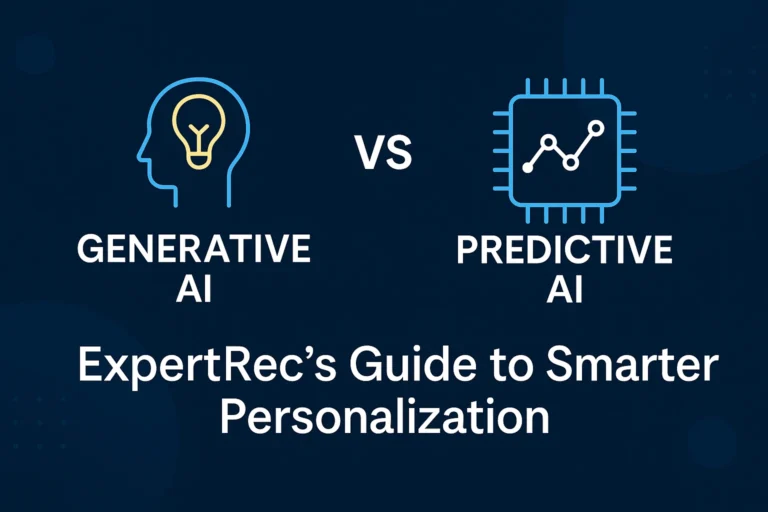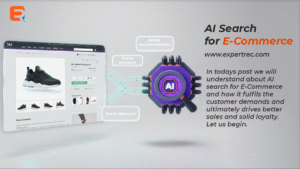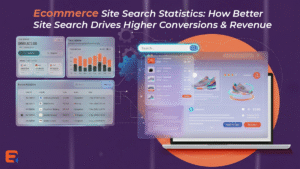If Generative AI is the artist of technology, Predictive AI is the strategist. One creates, the other foresees — and together, they’re reshaping how eCommerce brands like ExpertRec deliver personalized shopping experiences that feel uniquely human.
Both types of AI are transforming digital commerce, yet each serves a different purpose. Understanding how they work helps businesses choose the right tools to boost engagement and conversion.
What Is Generative AI?
Generative AI focuses on creation — turning data into new content such as text, images, videos, or audio. Instead of simply analyzing patterns, it uses those patterns to make something new.
How It Works
Generative models like Transformers, GANs (Generative Adversarial Networks), and Diffusion Models learn from large datasets to replicate human-like language or design.
What It Can Do
- Content Creation: Automatically write product descriptions or marketing copy.
- Visual Design: Generate ad banners or UI concepts from text prompts.
- Conversational AI: Power chatbots that respond naturally to customers.
- Data Enrichment: Fill missing attributes for new SKUs and catalog entries.
Example: A fashion retailer can use Generative AI to create on-brand product copy and banner ads in seconds, freeing creative teams to focus on strategy.
Generative AI unlocks creativity at scale — but needs careful guidelines to avoid inaccurate or off-brand outputs.
What Is Predictive AI?
Predictive AI is the analyst — focused on forecasting outcomes using historical and real-time data. It finds patterns that reveal what users are likely to do next.
How It Works
Predictive AI uses machine-learning models like decision trees and neural networks to turn past behaviour into future insight.
Common Use Cases
- Product Recommendations: Predict which items best match a user’s intent.
- Search Optimization: Rank results by likelihood of engagement.
- Customer Retention: Spot shoppers likely to churn and trigger re-engagement.
- Demand Forecasting: Anticipate inventory needs to avoid stockouts.
Predictive AI drives precision and profitability by turning data into action — and that’s exactly what powers ExpertRec’s recommendation engine.
Generative vs Predictive AI: Key Differences
| Feature | Generative AI | Predictive AI |
| Purpose | Create new content | Forecast behaviour and trends |
| Data Type | Unstructured (text, images) | Structured historical data |
| Output | Text, visuals, creative assets | Predictions, probabilities |
| Best For | Chatbots, design, marketing | Personalization, ranking |
| Strategic Role | Creator | Strategist |
Generative AI asks “What can I create?” Predictive AI asks “What will happen next?”
How ExpertRec Uses Predictive AI Today
ExpertRec analyzes real-time customer interactions — clicks, searches, and purchases — to forecast what each shopper wants next and personalize recommendations accordingly.
The Process
- Behavior Tracking: Collects session and purchase signals.
- Intent Prediction: Models forecast probable next actions.
- Dynamic Ranking: Re-orders search results and product grids per session.
- Continuous Learning: Refines predictions as user data grows.
Example: When a customer views running shoes, ExpertRec instantly predicts related interests — socks, fitness watches, or smart bottles — increasing click-through and cart value.
The result: higher CTR, longer sessions, and more conversions without manual tuning.
(Related link: ExpertRec AI Product Recommendations)
How Generative AI Will Enhance ExpertRec’s Future
While Predictive AI drives today’s precision, Generative AI adds creativity and conversation for tomorrow’s commerce.
Future Use Cases
- Conversational Shopping Assistants: Chat interfaces that generate context-aware responses and recommendations.
- AI-Generated Product Content: Automatic titles, meta tags, and SEO descriptions for new listings.
- Dynamic Marketing Assets: Personalized banners and emails crafted for each user.
- Cold-Start Solutions: Synthetic data generation for new products with no interaction history.
Think of it as the perfect duo: Predictive AI decides what to show, Generative AI decides how to show it.
Future Trends in AI-Driven eCommerce
The line between Generative and Predictive AI is blurring — and that’s good news for retailers. Here’s what’s coming next:
- Hyper-Personalization Everywhere: AI crafts product pages and messages unique to each shopper.
- Real-Time Decision Engines: Predictive AI spots patterns; Generative AI creates responses instantly.
- AI You Can Trust: Transparent algorithms explain why a product is recommended.
- Industry-Specific AI: Models fine-tuned for verticals like fashion, electronics, and health.
(External source: McKinsey – How AI Is Boosting Retail Personalization)
Why Both AI Types Matter for ExpertRec Clients
- Predictive AI delivers relevance and accuracy.
- Generative AI adds creativity and personal touch.
Together, they enable context-aware personalization — every search result, product suggestion, and message feels intentional and human.
For marketers, that means:
✅ Faster deployment with no developer dependence
✅ Measurable ROI from personalization initiatives
✅ Cross-channel consistency across email, search, and web
Final Thoughts
Generative AI brings creativity. Predictive AI brings precision. Together, they’re the future of personalization.
With ExpertRec’s AI Product Recommendation Engine, businesses can:
- Personalize every channel in real time,
- Recover abandoned carts faster, and
- Increase conversions through human-like intelligence.




